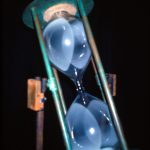- Hourglass (1/2 hour)
Post Gallery, Los Angeles, California, 2000
hourglass, phosphor, steel, fabric, light, sound
This site and time-specific installation addressed the experiential nature of the perceptions of space and time. Installed in an old freight elevator that moved visitors between levels in the gallery, the use of the transparent hourglass was an attempt to make time “visible” at the turn of the millennium. The exhibition was the first of the year 2000 at the Post Gallery.
Throughout ancient civilizations, light, from both sun and moon, has been one of the important factors in the measurement of time. In the 7th century, water, in addition to light, became a methods to measure time in Japan. In Passage of Time, light, sound, and interactive sculpture created a temporal experience during the short elevator ride.
The interior and exterior of the elevator were covered with black fabric to eliminate light while still allowing entrance. A large-scale hourglass, containing natural phosphor minerals, was placed at the center of the elevator. By turning the hourglass, visitors triggered the upward or downward motion of the elevator, causing the elevator light to extinguish, and leaving the persons inside in almost total darkness.
The only light came from the blue glow of the phosphorescent minerals as they fell within the hourglass and visually marked the passage of time. A sound of water dropping into an ancient earthen vessel recorded in the garden of a Japanese temple echoed simultaneously, reminding participants that this was a short journey through time in an intimate space.


